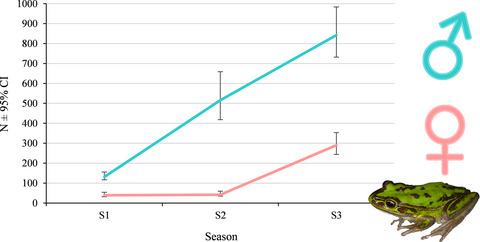当前位置:
X-MOL 学术
›
Austral Ecol.
›
论文详情
Our official English website, www.x-mol.net, welcomes your
feedback! (Note: you will need to create a separate account there.)
Identifying a limiting factor in the population dynamics of a threatened amphibian: The influence of extended female maturation on operational sex ratio
Austral Ecology ( IF 1.6 ) Pub Date : 2021-08-16 , DOI: 10.1111/aec.13098 Chad T. Beranek 1, 2 , Cassandra Maynard 1 , Colin McHenry 1, 2 , John Clulow 1, 2 , Michael Mahony 1
Austral Ecology ( IF 1.6 ) Pub Date : 2021-08-16 , DOI: 10.1111/aec.13098 Chad T. Beranek 1, 2 , Cassandra Maynard 1 , Colin McHenry 1, 2 , John Clulow 1, 2 , Michael Mahony 1
Affiliation

|
Understanding amphibian population dynamics is integral to mitigating severe declines that are occurring due to threats such as habitat removal and chytrid-induced disease. Few studies have focused on sex-specific population dynamics, despite the potential for these processes to alter colonisation and population turn-over in newly created habitats. Here, we investigate sex-specific population dynamics in the threatened green and golden bell frog (Litoria aurea) using intensive capture-recapture methods in a newly created wetland complex and control sites. As hypothesised, females took longer to reach maturity compared to males. The length of female maturation was 3.9 times greater than that of males (428.68 days ± 107.6 SD and 110.16 days ± 20.59 SD, respectively). This resulted in a one-year delay in female population size increase compared to the male population. The operational sex ratio (OSR) in the second year of monitoring in the created wetlands had the most disproportionate male bias out of any year and any site (12/1 male/female, male proportion = 0.92 ± 0.89–0.94 95% CI). In the third year, the OSR had become less male biased (2.6/1, male proportion = 0.72 ± 65–0.78 95% CI), likely attributed to the maturing of the females produced in the first year breeding events. We did not find any evidence that survival or detection probability influenced the observed OSRs in the created wetlands. Based on survival rates of each sex, we estimate that males are 77 times more likely to reach sexual maturity compared to females. We postulate that the combination of chytrid-induced disease and sex-biased maturation rates may be a driver of declines, especially in populations with limited recruitment. We encourage future research into investigating sex-specific population dynamics of amphibians, especially relating to reintroduction ecology and disease.
中文翻译:

确定受威胁两栖动物种群动态的限制因素:延长女性成熟期对操作性别比的影响
了解两栖动物种群动态对于缓解由于栖息地移除和壶菌引起的疾病等威胁而发生的严重下降是不可或缺的。很少有研究关注特定性别的种群动态,尽管这些过程有可能改变新创建栖息地的殖民化和种群周转。在这里,我们调查了受威胁的绿色和金铃蛙(Litoria aurea) 在新建的湿地综合体和控制点使用密集的捕获-再捕获方法。正如假设的那样,与男性相比,女性需要更长的时间才能达到成熟。女性成熟的长度是男性的 3.9 倍(分别为 428.68 天 ± 107.6 SD 和 110.16 天 ± 20.59 SD)。与男性人口相比,这导致女性人口规模增长延迟了一年。在人工湿地监测的第二年中,操作性性别比(OSR)在任何年份和任何地点中男性偏向最不成比例(12/1 男性/女性,男性比例 = 0.92 ± 0.89–0.94 95% CI) . 在第三年,OSR 变得不那么偏向雄性(2.6/1,雄性比例 = 0.72 ± 65–0.78 95% CI),这可能归因于第一年繁殖事件中产生的雌性成熟。我们没有发现任何证据表明生存或检测概率会影响所创造湿地中观察到的 OSR。根据每种性别的存活率,我们估计男性达到性成熟的可能性是女性的 77 倍。我们假设壶菌引起的疾病和性别偏见成熟率的结合可能是下降的驱动因素,特别是在招募有限的人群中。我们鼓励未来研究调查两栖动物的性别特定种群动态,特别是与重新引入生态学和疾病有关的研究。我们假设壶菌引起的疾病和性别偏见成熟率的结合可能是下降的驱动因素,特别是在招募有限的人群中。我们鼓励未来研究调查两栖动物的性别特定种群动态,特别是与重新引入生态学和疾病有关的研究。我们假设壶菌引起的疾病和性别偏见成熟率的结合可能是下降的驱动因素,特别是在招募有限的人群中。我们鼓励未来研究调查两栖动物的性别特定种群动态,特别是与重新引入生态学和疾病有关的研究。
更新日期:2021-08-16
中文翻译:

确定受威胁两栖动物种群动态的限制因素:延长女性成熟期对操作性别比的影响
了解两栖动物种群动态对于缓解由于栖息地移除和壶菌引起的疾病等威胁而发生的严重下降是不可或缺的。很少有研究关注特定性别的种群动态,尽管这些过程有可能改变新创建栖息地的殖民化和种群周转。在这里,我们调查了受威胁的绿色和金铃蛙(Litoria aurea) 在新建的湿地综合体和控制点使用密集的捕获-再捕获方法。正如假设的那样,与男性相比,女性需要更长的时间才能达到成熟。女性成熟的长度是男性的 3.9 倍(分别为 428.68 天 ± 107.6 SD 和 110.16 天 ± 20.59 SD)。与男性人口相比,这导致女性人口规模增长延迟了一年。在人工湿地监测的第二年中,操作性性别比(OSR)在任何年份和任何地点中男性偏向最不成比例(12/1 男性/女性,男性比例 = 0.92 ± 0.89–0.94 95% CI) . 在第三年,OSR 变得不那么偏向雄性(2.6/1,雄性比例 = 0.72 ± 65–0.78 95% CI),这可能归因于第一年繁殖事件中产生的雌性成熟。我们没有发现任何证据表明生存或检测概率会影响所创造湿地中观察到的 OSR。根据每种性别的存活率,我们估计男性达到性成熟的可能性是女性的 77 倍。我们假设壶菌引起的疾病和性别偏见成熟率的结合可能是下降的驱动因素,特别是在招募有限的人群中。我们鼓励未来研究调查两栖动物的性别特定种群动态,特别是与重新引入生态学和疾病有关的研究。我们假设壶菌引起的疾病和性别偏见成熟率的结合可能是下降的驱动因素,特别是在招募有限的人群中。我们鼓励未来研究调查两栖动物的性别特定种群动态,特别是与重新引入生态学和疾病有关的研究。我们假设壶菌引起的疾病和性别偏见成熟率的结合可能是下降的驱动因素,特别是在招募有限的人群中。我们鼓励未来研究调查两栖动物的性别特定种群动态,特别是与重新引入生态学和疾病有关的研究。











































 京公网安备 11010802027423号
京公网安备 11010802027423号